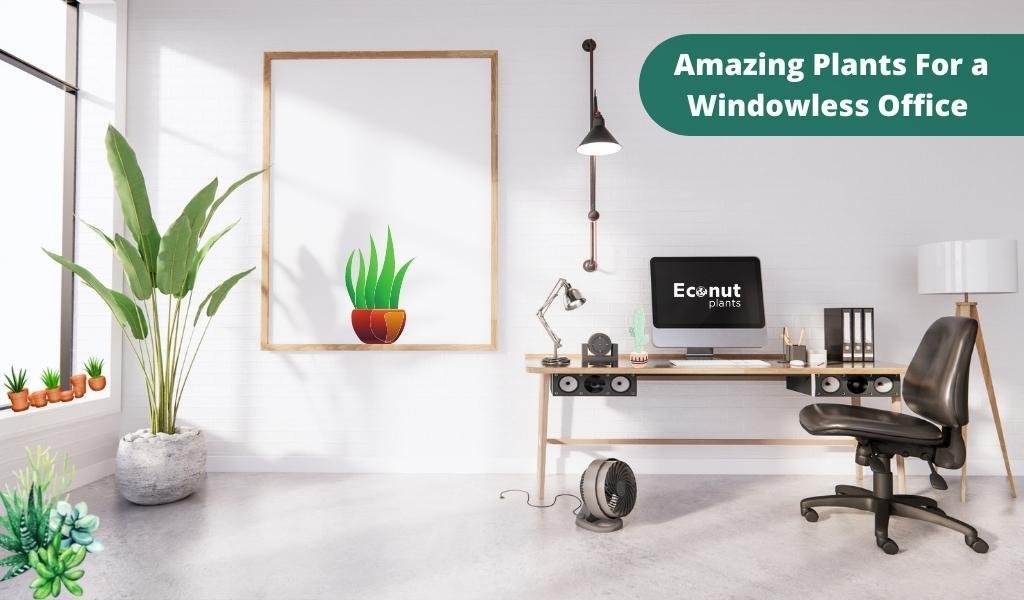Generally, the majority of people spend their time at their work places, and some places don’t have any windows where they can breathe fresh air. Thus, it is best to grow indoor office plants that grow without natural sunlight, as it is beneficial to improve work efficiency as well as health.
In this guide, you will find a few amazing indoor office plants that grow with no windows and make the environment serene and beautiful in an indoor space.
Best Windowless Indoor Office Plants
- Zamioculcasi
- Succulents
- Sansevieria
- Philodendron
- Peacock plant
- Maidenhair Fern
- English Ivy
1. Zamioculcasi
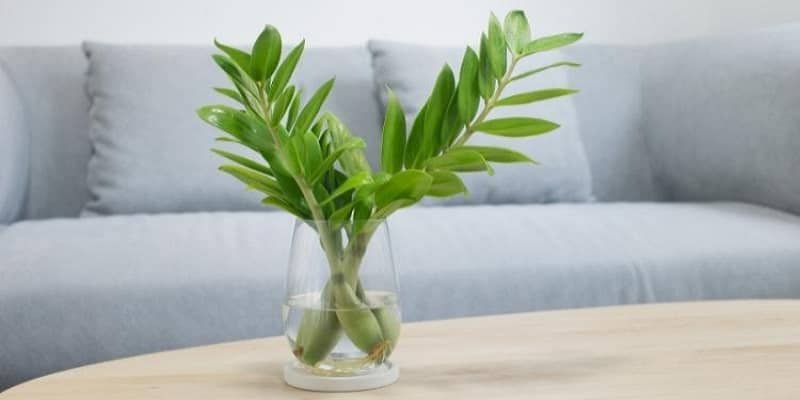
Scientific name: Zamioculcas zamiifolia
It works better in environments with both low and high lighting, so you can keep it anywhere. The Zamioculcasi plant is also known as the ZZ plant. It has a short life cycle, with approximately 4 months without water in indoor space. These plants have been popular since ancient times, and they are native to Africa. In 1996, these plants were started by Dutch nurseries, which are situated in South Africa. The prima negative effects of all the parts of the ZZ plant are poisonous. Therefore, you can keep them away from children, animals, and pets. Too much watering is one of the major causes of the death of the ZZ plant.
2. Succulents

As you can see, the majority of plants produce only their own food. However, these plants also store water and nutrients in their different body parts, such as stems and roots. They can give you a bright and beautiful environment in your home. Interestingly, NASA research centers use these plant in bio-homes as they remove toxic pollutants from the air and water by using them as food for plants and provide fresh air in the environment. Therefore, it gives natural beauty to your home. Due to that, you will not feel bored without any natural light. It also helps to increase the humidity. So ultimately, it can work as a blessing for everyone in the case of getting relief from dangerous diseases. They release oxygen into the air, so you can breathe fresh air.
According to research by Michigan University, it is also a beneficial plant to boost memory power by interconnecting with nature. Thus, you may keep them in school, colleges, work places, and at home as well, wherever you need a strong memory.
3. Sansevieria
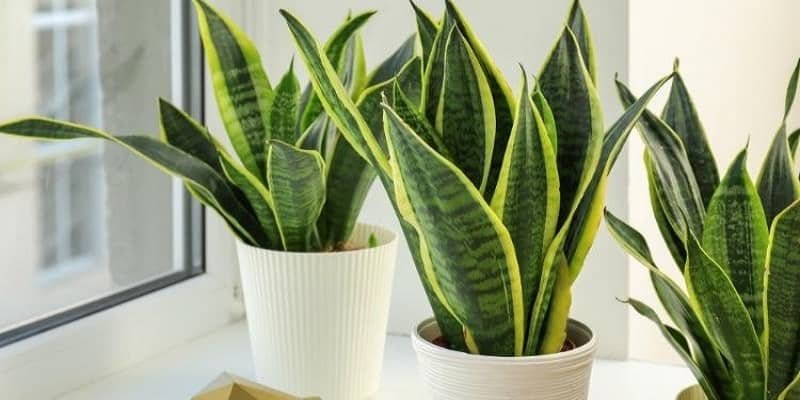
Scientific name: Dracaena trifasciata
These plants’ origins are in Asia and Africa. It has green leaves in a sword-shaped shape. It contains many different species of plants, like snake plants. Some species are poisonous. Thus, it is necessary to avoid these plants as food. It purifies indoor air, even at night, by converting carbon dioxide into oxygen. It has the ability to remove hazardous pollutants from the environment. Moreover, it helps to increase mental health. So it is a blessing for those who have mental health problems. These plants are easy to care for as they don’t require more fertilizer for growth. You can also relieve minor physical ailments. These plants bring positivity around the area and good luck for everyone’s spiritual purpose.
4. Philodendron
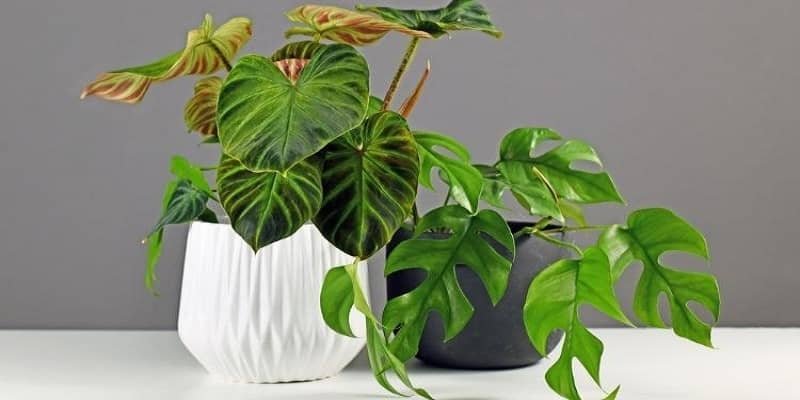
Scientific name: Thaumatophyllum bipinnatifidum
Philodendron is a native plant of North, Central, and South America. However, nowadays, you can find these plants everywhere in the world. Some species are poisonous to animals and pets. You can find these indoor office plants in an interesting variety of shapes and sizes. They do not require too much care, like other plants. So, it is easy to grow for people who have a hectic schedule. There are numerous varieties of these plants, but the heart-shaped leaf plant is the most suitable for growing indoors.
The main advantage of philodendron plant leaves is that they improve air quality for good breathing. These plants provide great relaxation and remove your stress and burden. You should put water in it once every 10 days. It needs balanced fertilizers. You should put manure down every month during spring. These plants generally survive for about 20 years. It does not require high maintenance to grow quickly. They only take 10 days to 3 weeks to reach their mature level. The most striking feature is that you can also grow these plants in water the mixture of soil.
5. Peacock Plant

Scientific name: Calathea makoyana
Peacock plants are native to Brazil. The leaves of these plants are long and look like peacock color, so they are called peacock color. The height of these plants is approximately 2 feet. Appropriate water and humidity levels are required for better peacock plant growth. You need to give water to the peacock plant when it feels a little bit of dry soil. Every 2-4 weeks during spring, fertilize your peacock plant as it grows fast in this time period. However, they do not require fertilizer in the winter. Sometimes, plants can
die because of overwatering, especially during wet weather. The peacock plant is a non-poisonous plant. Thus, it is not harmful to humans, animals, and pets. You can keep it anywhere at home as well as in the office. These plants’ leaves are closed at night and reopen in the morning.
6. Maidenhair Fern
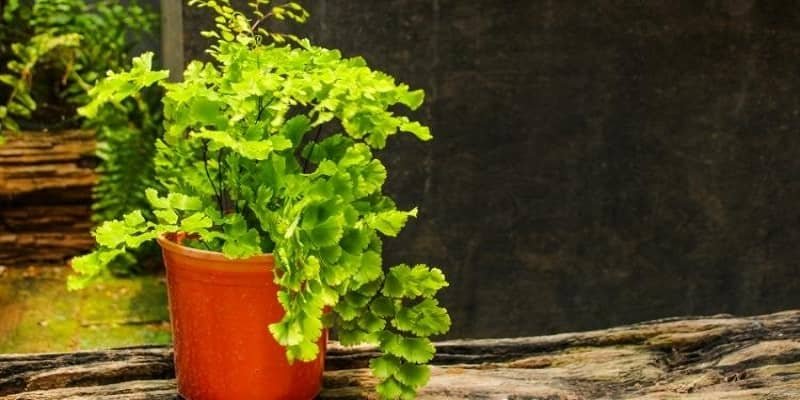
Scientific name: Adiantum
The maidenhair fern plant is found in Western America and East Asia, along with North America. These plants have long, thin, black ferns that look like hair, so they are commonly known as maidenhair ferns. These plants do not tolerate direct sunlight as it will cause burnt foliage. Maidenhair fern is used for the treatment of various health issues, such as coughs, menstrual cramps, hair fall, and so on. However, it has not been proved scientifically. These plants reproduce asexually by branching, instead of sexually through seeds. They have many medicinal properties, such as an anti-obesity effect.
7. English Ivy

Scientific name: Hedera helix
English ivy is classified as a woody vine. The plant’s height is about 80 feet high, and it is a climbing plant. They need organic soil. Thus, it is necessary to check the quality of the soil before planting. These plants are native to Europe, Western Asia, and Northern Africa. English ivy is a poisonous plant, but it contains an amazing chemical known as an expectorant, which aids in cough relief. Besides this, it also has some other health benefits, such as removing skin ailments and cancer. It is also helpful for wildlife. It is a food source for bees and butterflies.
Above, the given plants are examples of indoor plants, which grow with low maintenance and without sunlight. Indoor office plants with no windows are the most appropriate plants for improving the quality of indoor space and creating beautiful surroundings. You should try to learn about these kinds of plants as they help to boost natural beauty as well as the health of people. So, it is obviously beneficial for your health. They do not need too much care, like other plants.
Hope, you liked reading the guide. If you think we have missed something or have any suggestion, please drop your valuable opinion in the comment section below.
If you are searching fresh and live houseplants online then checkout our extensive collection of amazing indoor and outdoor houseplants.

